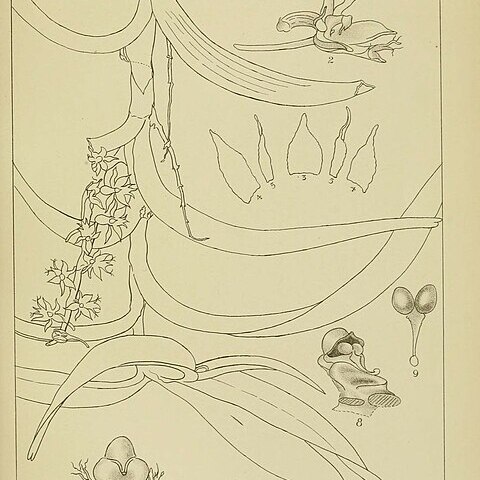Plants epiphytic or epilithic; stems simple, stout, usually erect, to 350 mm tall and 4-6 mm in diameter; roots separated from the leaves by a length of bare stem; leaves not imbricate, leathery, somewhat succulent, linear-lorate, rounded, unequally bilobed, 30-120 (-150) x 7-12 mm. Inflorescences from the axils of the lower leaves, as well as from the sheaths of dehisced leaves; racemes arcuate, 30-80 mm long and with 6-20 flowers. Flowers star-like, c. 10 mm in diameter, pale yellowish-brown. Sepals spreading, sometimes twisting; median narrowly oblong, obtuse, 3.5-6 x 2-2.5 mm; laterals ovate, acute, 4-6 x 2.5-3 mm. Petals lorate, acute, 3.5-4.5 x 1-1.2 mm, margins often uneven. Lip obtriangulate, 5 mm long and 5-6 mm wide at the apex, basal calli prominent, tridentate, teeth 1.5-2 mm long; central tooth acute; laterals lobed at the apex, often longer than the central tooth; spur 9-13 mm long. Gynostemium 2 mm tall. Capsules spheroidal to ellipsoid, 12 x 7 mm.
Plants epiphyte or lithophyte, up to 0.5 m high. Stems erect, up to 350 mm long. Leaves not imbricate, leathery, somewhat succulent, linear-lorate, unequally bilobed, rounded, 30-120 x 7-12 mm. Inflorescence borne in axils of leaves, as well as dehisced leaves, racemose arcuate, 30-80 mm long, 6-20-flowered. Flowers pale yellowish brown, star-like, 10 mm in diam. Sepals spreading, twisting; median sepal narrowly oblong, 3.5-6.0 x 2 mm; lateral sepals ovate 4-6 x 3 mm. Petals lorate, acute, 3-5 x 1.5 mm, margins uneven. Lip obtriangulate, 5 mm long, 5-6 mm wide at apex, basal calli prominent, tridentate, teeth 1-2 mm long; spur 9-13 mm long. Flowering time Oct.-Feb.
Stout, monopodial epiphyte or lithophyte to 35 cm. Leaves leathery, somewhat succulent, oblong, notched apically. Flowers few to many in a dense, axillary raceme, ± 10 mm diam., pale yellowish brown, lip tridentate with side lobes fringed apically, spur 9-13 mm long.
Leaves distichous, very variable in size and texture, depending largely on degree of exposure to light, 6–15 × 0.6–1.8 cm, linear or ligulate, unequally 2-lobed at the apex, thin-textured and flat, or fleshy and conduplicate.
Lip auricled at the base, 4–6 mm long, 3-lobed at about halfway; mid-lobe 2–3 mm long, triangular; side lobes spreading, 3–5.5 mm long, linear, laciniate at the apex; spur 10–20 mm long, straight.
Inflorescences arising along the stem, 3.5–13 cm long, densely up to c. 25-flowered, the flowers in 2 rows, all facing the same way.
Sepals 4–6 × 1.5–4 mm, ovate, acute, the lateral sepals oblique and slightly longer and wider than the dorsal sepal.
Stems erect or pendent, woody, 20–80 cm long, seldom branched, covered with old leaf bases.
Roots 2–8 mm in diameter, smooth or very slightly verrucose.
Flowers white, pink or yellow, often with a green tinge.
Flowers yellowish, yellow-green or dingy-cream.
Petals 4–6 × 1–2 mm, narrowly oblong.
Bracts sheathing, 1–2 mm long.
Pedicel and ovary 3–6 mm long.
Robust epiphytic herbs.
Column 1–1.7 mm long.

